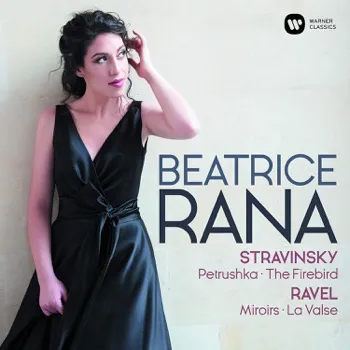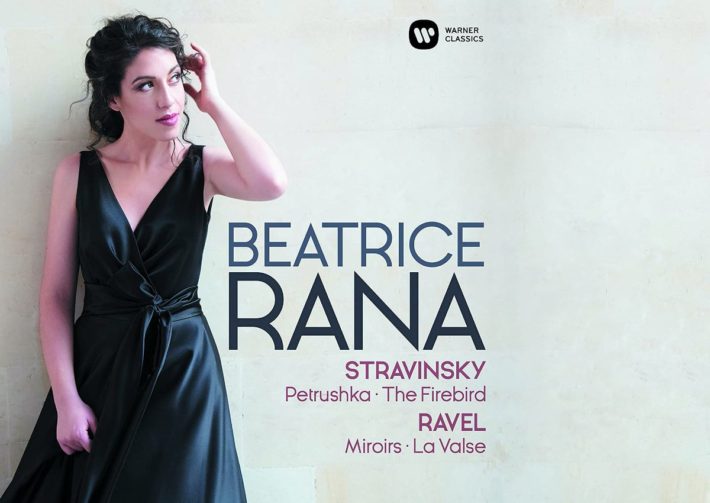Beatrice Rana, second-prize winner of the 2013 Van Cliburn Competition, releases a new Warner Classics recording of works by Ravel and Stravinsky. Her performance is nothing short of stunning: flawless technique serves as a backdrop for her mature interpretation of both composers. Rana’s Ravel does not just illustrate the programmatic nature of the pieces, but tells a vivid story. Her Stravinsky takes to the heart the essence of orchestral transcription, using the piano to not only convey the nuanced timbres of different instruments, but also its power to represent a full orchestra’s richness.

ana’s interpretation of Miroirs shows her solid understanding of Ravel’s musical style, so heavily based upon harmonic color. Composed between 1904-1905, Ravel dedicated each movement to a member Les Apaches, an avante-garde group of artists of which he was a part. Each movement is a vignette; what Rana does so well is observing Ravel’s idiom while still giving each piece its distinct character, ranging from impish (Noctuelles) to melancholy (Oiseaux tristes). Of particular note is her Une Barque sur l’océan, which has the diaphanous quality of Gieseking (1954) but that adds an excellent balance of melodic lines. Her playing presents an interweaving of different melodic threads, each of a different personality.
In a most nuanced way, she expresses the chiming upper voice, the resonant middle notes and the arpeggiated flowing accompaniment. through her sensitivity, a listener can easily picture what Ravel’s title suggests. She also pays detailed attention to harmonic color changes throughout. Another impressive movement is Alborada Del Gracioso (track 4). Where an interpretation like that of Bertrand Chamayou (Erato, 2016) expresses the graceful, perhaps humorous nature of the jester (the title roughly translates to “Morning Song of a Jester”), Rana’s interpretation is fiery. Her opening (try the first 30 seconds) is measured and rhythmic along the lines of Gieseking and shows incredible clarity with crisp and snappy notes, giving way to bursts of passion (0’39”). The quieter middle section maintains difference of character in different registers and is a well-thought out contrast with the outer-lying sections.
Rana’s La Valse is both beautiful and exciting. It shows good establishment of the waltz rhythm from the start, which becomes essential to the motion of the entire piece. From the performance aspect, this can be a bit tricky given the low register of the piano and soft dynamic; however, her notes are clear and articulated. This in fact goes for all the notes she plays: unlike Debussy, Ravel writes in an interestingly mathematical fashion with specific note groupings. Rana manages to reconcile this specificity with the fluidity that the waltz requires. Her clear articulation is partly due to wise pedalling. Where Yeol Eum Son’s recording (Decca, 2016) uses a little too much pedal at the opening, Rana is mindful, almost sparing in her usage. Each phrase is given ample care from start to finish; this is especially true in her right hand which sings coyly, with a charming and almost pleading nature. The only issue with Rana’s phrasing is the slightly exaggerated ritardando, done at the ends, which can get a little predictable. A recording that balances good phrasing and rhythmic continuity well is Ruth Laredo’s (1982, CBS Classics); her interpretation takes very few bends in tempi but still reflects the spirit of the waltz.
Rana puts forth a solid 3 movements of Petrushka, but it is her interpretation of the first movement that shines. Although her opening could use more of the shrill quality of the high winds in the orchestral version (something that Pollini in his celebrated 1971 DG recording does very well), her playing speaks to the fullness of the ensemble. At the same time, it expresses the delicacy of the piano’s upper register (1’04 – 1’17”). The first movement in particular can end up being played for virtuosity’s sake, but Rana’s interpretation is powerful while always putting good sound quality at the forefront.
The highlight of her Stravinsky interpretations is certainly The Firebird. The arrangement is by Guido Agosti, an Italian pianist who studied with Busoni. This piece is nothing short of a pianistic nightmare in terms of difficulty, but Rana demonstrates absolute mastery of it. In the Danse Infernale (track 6), her virtuosity comes through naturally. As in Petrushka, she pays attention to the orchestral basis of the piece, using all registers of the piano to represent a wide variety of orchestral timbres. She does a very good job with transitioning smoothly between different characters and sections of the movement; this is done very well between middle lyrical section back into the rhythmic section (2’44”). The Berceuse is lyrical, sensitive and has many delicate shades of color.
The pianistic writing of the transcription poses a challenge to a performer: the melody is essentially written between two layers of accompaniment, so there is a lot of manoeuvring needed between the two hands. Rana not only executes this seamlessly, but manages to incorporate a high level of expressive phrasing that mimics the plaintive nature of the bassoon which introduces the melody in the orchestral version.
The sound engineering of the CD complements Rana’s performance, highlighting her clarity throughout. The liner notes too are well done, as they feature Rana’s own words about each of the works and gives the listener her honest and evocative insights.
Ravel – Miroirs, La Valse
Stravinsky – Petrushka, The Firebird (arr. Agosti)
Beatrice Rana – Piano
Warner Classics, CD 190295411091




















